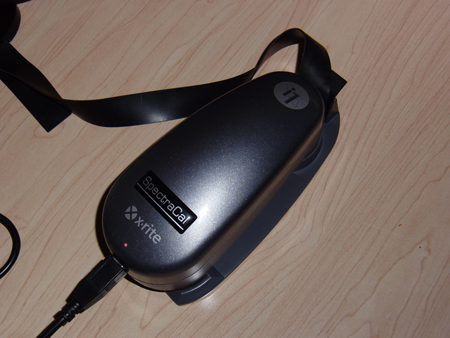Acer, Dell, LG, And Samsung: Four 23" LCD Monitors, Rounded-Up
Benchmark Methodology And Test Setup
It's a new year, and we're taking the opportunity to look back at our testing methodology and try to simplify it to make it a little more accessible. We're not changing the hardware we use or the way we use it, and we still think that test patterns are too subjective.
That’s why we’re still relying on our spectrophotometer and monitor calibration software (specifically, a Spectracal-certified i1Pro, Spectracal's CalMAN [luminance and gamut measurements], X-Rite's i1Match [default state], and ColorEyes Pro [calibration] to examine specific performance characteristics).
Previously, our display benchmark suite generated a ton of results, and that density made the benchmarks difficult to cut through. In order to make our measurements and analysis more intuitive, we’re only recording the non-calibrated performance of luminance and contrast. At the end of the day, those are the only two variables that matter to folks who plan to buy a monitor, but don't anticipate calibrating it.
Unfortunately, when it comes to color production, we do have to calibrate our displays in order to offset other variables like brightness, color temperature, and gamma.
If you, personally, want to see other aspects of display performance measured, let us know in this story's feedback thread. We read through all of the commentary, and will try to accommodate requests where it makes the most sense. In the meantime, our current suite gives you a good idea of what to expect, whether you are gaming or just watching video on Hulu.
| Test Hardware | |
|---|---|
| Processor | Intel Core i5-2400 (Sandy Bridge), 32 nm, 3.1 GHz, LGA 1155, 6 MB Shared L3, Turbo Boost Enabled |
| Motherboard | Gigabyte GA-Z68X-UD7-B3 |
| Memory | Kingston Hyper-X 8 GB (2 x 4 GB) DDR3-1333 @ DDR3-1333, 1.5 V |
| System Drive | OCZ Vertex 3 240 GB SATA 6Gb/s |
| Graphics | Palit GeForce GTX 460 1 GB |
| Power Supply | Seasonic 760 W, 80 PLUS Gold |
| Calibration Tools | X-Rite i1Pro |
| System Software and Drivers | |
| Operating System | Windows 7 x64 Ultimate |
| DirectX | DirectX 11 |
| Driver | Graphics: Nvidia 270.61 RST: 10.6.0.1002 Virtu: 1.1.101 |
Current page: Benchmark Methodology And Test Setup
Prev Page Acer S231HL Bid, Dell S2330MX, LG IPS236V, And Samsung S23A550H Next Page Out Of Box Performance: Maximum And Minimum BrightnessGet Tom's Hardware's best news and in-depth reviews, straight to your inbox.
-
compton I thought the LG used not S-IPS but e-IPS, 6 bit + AFC. I actually thought it was almost identical to the CCFL backlit Dell U2311H (except the module is for LED backlight in the LG's case, not CCFL).Reply
I guess I was wrong. -
klyzet Im not sure if that input lag test is accurate.Reply
Why dont you guys test it the usual way? with a CRT monitor side by side running a timer (with ms ofc) and take some photos? -
illusiongamer12 why no review a viewsonic monitor they have a 150$-180$ monitor with these same specsReply -
tlmck Also noticeably absent is the ever popular ASUS brand. I don't have one myself, but it seems a lot of people do. Would have been an interesting comparison.Reply -
Eman25th Can anyone tell me why the prices haven't dropped? i bought my asus 24" screen 2 years ago for 178$Reply -
acku Reply9527531 said:I thought the LG used not S-IPS but e-IPS, 6 bit + AFC. I actually thought it was almost identical to the CCFL backlit Dell U2311H (except the module is for LED backlight in the LG's case, not CCFL).
I guess I was wrong.
LG's QA website. -
kyuuketsuki I own the LG IPS236V, and I find your numbers completely non-believable. The contrast ratio is not that abysmal, and it can reproduce decent (though not the best, I admit) blacks. Also, on a review of the IPS226V, while being the 22" model, it is otherwise identical, and DigitalVersus found it to have a contrast ratio of over 1000:1. I'm wondering where the huge disparity in numbers is coming from, and I don't think it's DigitalVersus mussing things up.Reply
Question: did you go into the Menu > Picture and change the Black Level setting to Low? It defaults to High for some unknown reason, and at that setting the blacks are indeed terrible. At Low, the blacks are much, much better, and the slight decrease in white levels isn't much of an issue given that this is an extremely bright monitor. -
acku Reply9527539 said:I own the LG IPS236V, and I find your numbers completely non-believable. The contrast ratio is not that abysmal, and it can reproduce decent (though not the best, I admit) blacks. Also, on a review of the IPS226V, while being the 22" model, it is otherwise identical, and DigitalVersus found it to have a contrast ratio of over 1000:1. I'm wondering where the huge disparity in numbers is coming from, and I don't think it's DigitalVersus mussing things up.
Question: did you go into the Menu > Picture and change the Black Level setting to Low? It defaults to High for some unknown reason, and at that setting the blacks are indeed terrible. At Low, the blacks are much, much better, and the slight decrease in white levels isn't much of an issue given that this is an extremely bright monitor.
Gamma set to 2.2. We did set to low. And as you know we measure luminance (nits) not illuminance (lux). Maybe this unit sat in the review pool too long... Not sure, but those were the readings that we achieved.
